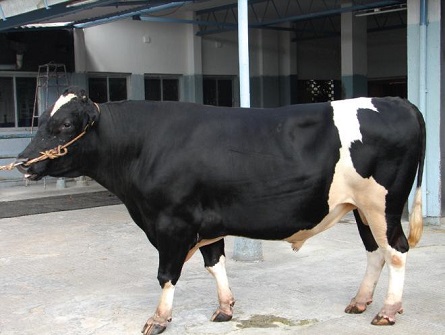
Introduction:
Rural livestock improvement is one of the core activity approaches of BAIF to ensure gainful self-employment and sustainable livelihood approach at the rural level. This activity is not only a tool for income generation and improvement of the quality of life of the rural population but also an opportunity for dairy population improvement. The method varies from using frozen semen from exotic breed dairy sires (Jersey or Holstein Friesian) to crossbreed rural indigenous (Zebu) cows to produce crossbreds with high milk potential to preserving and enhancing indigenous stock through their characterization and genetic improvement using frozen semen from chosen bulls through Artificial Insemination.
Breeding the field animals through natural service:
Traditionally, bulls have been used by natural service to impregnate females for producing calves. Since one bull is used for providing service to many females, his contribution to improvement becomes more important than that of females. In natural mating, while realizing the importance of the bull in transmitting good qualities to its progeny, it was also noticed that the level of impact was much less than desired due to the production of a few numbers of daughters during the year. The invention of Artificial Insemination (A.I.) created an opportunity to produce a large number of daughters from a bull to create a sizable impact of its inheritance, to genetically improve the milk production potential. Such a program was launched by BAIF right in the initial establishment years by importing frozen semen of highly merited bulls from Europe and America and thereafter from locally available selected bulls when semen freezing facilities were established and standardized.
Generation-wise contribution of sire:
Considering the objective of improving milk and the overall productive and reproductive performance of rural animals, the selection of top-class quality bulls for producing a large number of daughters to make the desired impact is necessary. In the 1st generation sire contributes 50 percent to the foundation stock, in the 2nd generation, his contribution is 75 percent and in the 3rd generation, 87.5 percent contributes from 3 sires to the foundation stock. (See the following Image) and the bull effect continues for 10 years.

Bull selection methods:
There are three popular methods for selecting bulls for breeding field animals and they are as follows;
1. Physical confirmation: In this bull selection method, more importance is given to the breed characters rather than the milk production potential of his dam. While selecting the bull it is also seen that the bull is free from any physical ailments like lameness, blindness, any damaged part of the body, etc. This bull selection method is used for draft-purpose breeds E.g. Khillar, Hallikar, Red Kandhari, etc,

2. Physical confirmation and pedigree selection: In this bull selection method along with physical confirmation, the bull’s pedigree (ancestors’ information) is also seen like, the milk production capacity of his dam, his sisters, and grand dam. If the pedigree information of three generations is available, then it is considered to be much better. This method is used for selecting the bulls from milk breeds and crossbreed animals.

3. Physical confirmation, pedigree, and progeny performance: This is the most reliable method of bull selection before the bull is put into extensive use. The developed countries that made extensive genetic improvements in milk production used this method on a very large scale. In this bull selection method, the selection of bulls is made after comparing a large number of bulls and selecting a top few of them to be used extensively. Since bulls themselves do not give milk, the average production of their daughters is considered for comparison. Standard procedures are defined for doing this and the process is known as progeny testing. The field progeny testing has prime importance as bulls are selected on the performance of daughters born at farmers’ herd and every farmer has his own feeding and management practices followed for their animals.

4. BAIF experience in progeny testing: The first field progeny testing attempt in BAIF was initiated during the period 1980-85. During this period, pure Holstein and Jersey breed bulls were progeny tested on the basis of their crossbred daughters produced under farmer conditions. This probably was the first attempt of this sort in the country.
The absence of information and experience on many aspects of field recording in the country calls for a need to build knowledge on the aspects of fine-tuning the recording system to increase the accuracy of progeny testing.

Dr. R. L. Bhagat
Senior Thematic Program Executive
BAIF, CRS, Uruli Kanchan, Pune

Great website you got here! Hope you keep updating and make people like me visit! It’ll be in my bookmarks so better update!